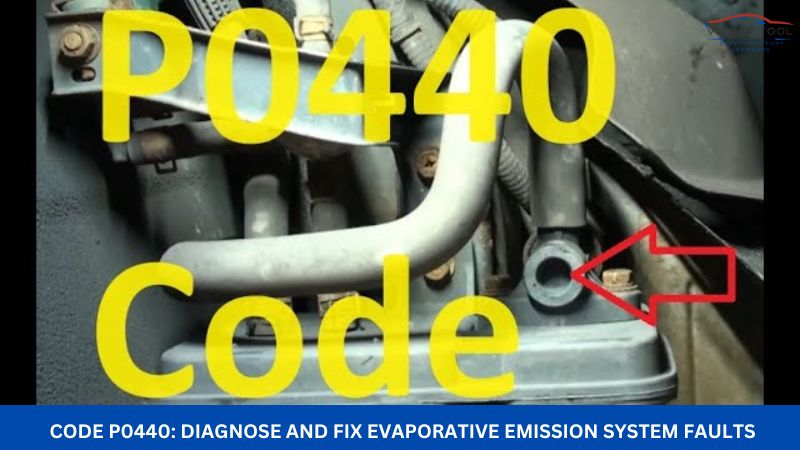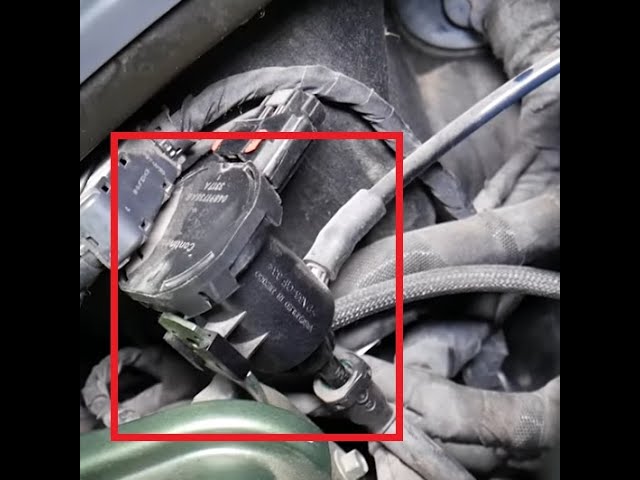Code P0440: Diagnose and Fix Evaporative Emission System Faults
Code P0440 indicates a problem with your car’s evaporative emission (EVAP) control system, but with VCCarTool, you can diagnose and resolve it effectively. This guide will help you understand the causes, symptoms, and fixes for this common OBD-II trouble code, ensuring your vehicle runs efficiently and minimizes emissions. Are you spending too much time chasing down EVAP leaks? Let VCCarTool assist with remote diagnostics, saving you time and money.
If you’re unsure how to repair, diagnose, or program the P0440 code, contact VCCarTool via WhatsApp: +1 (901) 414 – 1927 for assistance to avoid causing more serious errors.

1. Understanding the P0440 Code: Evaporative Emission System Malfunction
The P0440 code signifies a malfunction within the evaporative emission (EVAP) system. This system is designed to prevent fuel vapors from escaping into the atmosphere. The powertrain control module (PCM) detects a large leak or general malfunction within the EVAP system, setting the P0440 code. According to the Environmental Protection Agency (EPA), a properly functioning EVAP system is crucial for reducing harmful emissions and maintaining air quality.
1.1. What Does Code P0440 Mean?
The code indicates “Evaporative Emission Control System Malfunction.” This means the vehicle’s computer has detected a leak or other issue in the system that prevents fuel vapors from being properly contained.
1.2. What is the Evaporative Emission (EVAP) Control System?
The EVAP system captures fuel vapors from the fuel tank and prevents them from being released into the atmosphere. The system stores these vapors and then purges them into the engine to be burned during normal operation. This system includes components such as:
- Fuel cap
- Charcoal canister
- Purge valve
- Vent valve
- Fuel tank pressure sensor
- Hoses and lines
1.3. Why is the EVAP System Important?
The EVAP system plays a crucial role in reducing air pollution. Fuel vapors are a significant source of volatile organic compounds (VOCs), which contribute to smog and other environmental problems. The EVAP system prevents these vapors from escaping, helping to protect the environment. A study by the California Air Resources Board (CARB) found that malfunctioning EVAP systems contribute significantly to vehicle emissions, highlighting the importance of maintaining these systems.
2. Common Symptoms of Code P0440
Knowing the symptoms associated with code P0440 can help you identify the problem early. Here are the most common signs:
- Check Engine Light is illuminated on the dashboard.
- Fuel odor, especially after filling up the gas tank.
- Decreased fuel efficiency.
- Difficulty starting the engine.
- In some cases, no noticeable symptoms other than the illuminated Check Engine Light.

2.1. How Does the Check Engine Light Indicate a P0440 Issue?
When the PCM detects a problem with the EVAP system, it triggers the Check Engine Light. This light is a signal that something is not working correctly and needs attention.
2.2. Why Might I Smell Fuel?
A fuel odor indicates that fuel vapors are escaping from the EVAP system. This can be due to a loose or damaged fuel cap, a cracked hose, or a faulty valve.
2.3. Can Code P0440 Affect Fuel Efficiency?
Yes, a malfunctioning EVAP system can affect fuel efficiency. If fuel vapors are not being properly purged into the engine, it can cause the engine to run less efficiently.
3. Potential Causes of Code P0440
Understanding the potential causes of code P0440 can help you narrow down the problem and find the right solution. Here are some common causes:
- Loose or defective fuel cap: The most common cause.
- Cracked or damaged EVAP hoses: Hoses can dry out and crack over time, leading to leaks.
- Faulty purge valve: The purge valve controls the flow of fuel vapors into the engine.
- Faulty vent valve: The vent valve allows fresh air into the EVAP system.
- Cracked or damaged charcoal canister: The charcoal canister stores fuel vapors.
- Defective fuel tank pressure sensor: This sensor monitors the pressure in the fuel tank.
- Fuel tank leaks: A leak in the fuel tank can cause the P0440 code.
3.1. Why is the Fuel Cap a Common Culprit?
The fuel cap is a common cause because it is frequently removed and replaced, making it susceptible to damage or improper sealing. A loose or damaged fuel cap can allow fuel vapors to escape, triggering the P0440 code.
3.2. How Do Hoses and Valves Contribute to P0440?
Hoses and valves are critical components of the EVAP system. Over time, hoses can crack and valves can fail, leading to leaks and malfunctions.
3.3. What Role Does the Charcoal Canister Play?
The charcoal canister stores fuel vapors until they can be purged into the engine. If the canister is cracked or damaged, it can release vapors and trigger the P0440 code.
4. Diagnosing the P0440 Code: Step-by-Step Guide
Diagnosing the P0440 code requires a systematic approach. Here’s a step-by-step guide:
- Check the Fuel Cap: Ensure it is tightened and in good condition.
- Inspect EVAP Hoses: Look for cracks, leaks, or damage.
- Use a Scan Tool: Read the diagnostic trouble codes (DTCs) and freeze frame data.
- Test the Purge Valve: Ensure it opens and closes properly.
- Test the Vent Valve: Ensure it functions correctly.
- Perform a Smoke Test: This can help identify leaks in the system.
- Check the Fuel Tank Pressure Sensor: Ensure it is reading correctly.
4.1. Why is a Scan Tool Essential for Diagnosing P0440?
A scan tool allows you to read the DTCs and freeze frame data, providing valuable information about the problem. It can also be used to monitor the EVAP system components and perform tests.
4.2. How Does a Smoke Test Help Find EVAP Leaks?
A smoke test involves injecting smoke into the EVAP system and looking for where it escapes. This can help you find leaks that are not visible to the naked eye.
4.3. What Should I Look for When Inspecting EVAP Hoses?
When inspecting EVAP hoses, look for cracks, leaks, and damage. Also, check the connections to ensure they are secure.
5. Repairing the P0440 Code: Solutions and Steps
Once you have diagnosed the cause of the P0440 code, you can begin the repair process. Here are some common solutions:
- Replace the fuel cap if it is loose or damaged.
- Replace any cracked or damaged EVAP hoses.
- Replace the purge valve or vent valve if they are faulty.
- Replace the charcoal canister if it is cracked or damaged.
- Replace the fuel tank pressure sensor if it is not reading correctly.
- Repair any leaks in the fuel tank.
5.1. How Do I Replace a Fuel Cap?
Replacing a fuel cap is a simple task. Simply unscrew the old cap and screw on the new one until it clicks.
5.2. What is Involved in Replacing EVAP Hoses?
Replacing EVAP hoses involves disconnecting the old hoses and connecting the new ones. Make sure to use the correct size and type of hose.
5.3. Can I Replace the Purge Valve or Vent Valve Myself?
Yes, you can replace the purge valve or vent valve yourself. However, it is important to follow the manufacturer’s instructions and use the correct tools.
6. Preventing Future P0440 Codes
Preventing future P0440 codes involves regular maintenance and attention to the EVAP system. Here are some tips:
- Ensure the fuel cap is always tightened properly.
- Inspect EVAP hoses regularly for cracks or damage.
- Replace the fuel cap every few years.
- Address any fuel odors promptly.
- Consider a professional EVAP system inspection periodically.
6.1. Why is Regular Fuel Cap Maintenance Important?
Regular fuel cap maintenance helps prevent leaks and ensures that the EVAP system is properly sealed. A loose or damaged fuel cap is one of the most common causes of the P0440 code.
6.2. How Often Should I Inspect EVAP Hoses?
You should inspect EVAP hoses at least once a year or during every oil change. This will help you catch any problems early before they lead to a P0440 code.
6.3. What Are the Benefits of a Professional EVAP System Inspection?
A professional EVAP system inspection can help identify potential problems that you may not be able to see yourself. A technician can use specialized tools and knowledge to thoroughly inspect the system and recommend any necessary repairs.
7. Common Mistakes to Avoid When Dealing with Code P0440
- Ignoring the Code: Ignoring the P0440 code can lead to further damage and increased emissions.
- Replacing Parts Without Proper Diagnosis: Replacing parts without properly diagnosing the problem can be costly and ineffective.
- Not Tightening the Fuel Cap: Failing to tighten the fuel cap is a common mistake that can trigger the P0440 code.
- Using Incorrect Parts: Using incorrect parts can cause further damage and prevent the EVAP system from functioning properly.
7.1. Why Should I Not Ignore Code P0440?
Ignoring the P0440 code can lead to increased emissions, decreased fuel efficiency, and potential damage to other components. It is important to address the problem as soon as possible.
7.2. What is the Risk of Replacing Parts Without Diagnosing?
Replacing parts without properly diagnosing the problem can be costly and ineffective. You may end up replacing parts that are not actually faulty, wasting time and money.
7.3. How Can Incorrect Parts Affect the EVAP System?
Using incorrect parts can cause further damage and prevent the EVAP system from functioning properly. It is important to use the correct parts and follow the manufacturer’s instructions.
8. How VCCarTool Can Help with Code P0440
At VCCarTool, we specialize in providing solutions for complex automotive issues like the P0440 code. We understand the challenges faced by auto repair shops and technicians. That’s why we offer remote diagnostic services, advanced diagnostic tools, and comprehensive support to help you quickly and accurately resolve EVAP system problems.
- Remote Diagnostic Assistance: Our experienced technicians can provide remote assistance to help you diagnose the P0440 code and identify the root cause of the problem.
- Advanced Diagnostic Tools: VCCarTool offers a range of advanced diagnostic tools that can help you test and monitor the EVAP system components.
- Comprehensive Support: We provide comprehensive support and training to help you effectively use our tools and resolve EVAP system issues.
8.1. What Are the Benefits of Using VCCarTool’s Remote Diagnostic Assistance?
Our remote diagnostic assistance can save you time and money by helping you quickly and accurately diagnose the P0440 code. Our experienced technicians can provide expert guidance and support, helping you avoid costly mistakes.
8.2. What Advanced Diagnostic Tools Does VCCarTool Offer?
VCCarTool offers a range of advanced diagnostic tools, including scan tools, smoke machines, and pressure testers. These tools can help you test and monitor the EVAP system components, identify leaks, and verify repairs.
8.3. How Can VCCarTool’s Comprehensive Support Help Me?
Our comprehensive support includes training, troubleshooting assistance, and access to our knowledge base. We are committed to helping you effectively use our tools and resolve EVAP system issues.
By choosing VCCarTool, you’re not just getting a tool or service; you’re gaining a partner dedicated to your success. We understand the challenges you face and are committed to providing the solutions and support you need to excel.
9. Real-World Examples: Code P0440 Success Stories
Here are a couple of real-world examples from technicians who have previously worked with VCCarTool.
Success Story 1: Quick Diagnosis Saves Time
- Problem: A local repair shop was struggling with a P0440 code on a 2015 Honda Civic. They had already replaced the fuel cap and purge valve, but the code persisted.
- Solution: Using VCCarTool’s remote diagnostic assistance, our technician guided them through a smoke test, which quickly revealed a cracked hose behind the charcoal canister.
- Result: The shop replaced the hose, cleared the code, and the vehicle passed inspection. They saved valuable time and avoided unnecessary parts replacements.
Success Story 2: Accurate Diagnosis Prevents Unnecessary Repairs
- Problem: A technician was working on a 2012 Ford F-150 with a P0440 code. He suspected a faulty fuel tank pressure sensor but wasn’t sure.
- Solution: Using VCCarTool’s advanced scan tool, he monitored the sensor readings and confirmed that it was indeed faulty.
- Result: He replaced the sensor, cleared the code, and resolved the issue. He avoided the cost of replacing other components that were functioning correctly.
10. Frequently Asked Questions (FAQs) About Code P0440
- What does the P0440 code mean?
- The P0440 code indicates a malfunction in the evaporative emission (EVAP) control system, often due to a leak.
- Can I drive with a P0440 code?
- While it’s usually safe to drive with a P0440 code, it’s best to address it promptly to avoid potential damage and increased emissions.
- How do I fix a P0440 code?
- Fixing a P0440 code involves diagnosing the cause of the problem and then repairing or replacing the faulty component.
- What are the common causes of a P0440 code?
- Common causes include a loose or damaged fuel cap, cracked or damaged EVAP hoses, and a faulty purge valve or vent valve.
- How much does it cost to fix a P0440 code?
- The cost to fix a P0440 code can vary depending on the cause of the problem and the cost of the parts and labor.
- Can a bad fuel cap cause a P0440 code?
- Yes, a loose or damaged fuel cap is one of the most common causes of the P0440 code.
- How do I perform a smoke test on the EVAP system?
- A smoke test involves injecting smoke into the EVAP system and looking for where it escapes. This can help you find leaks that are not visible to the naked eye.
- What tools do I need to diagnose a P0440 code?
- You will need a scan tool, a smoke machine, and a pressure tester.
- Where is the EVAP purge valve located?
- The location of the EVAP purge valve can vary depending on the vehicle. Consult your vehicle’s repair manual for the exact location.
- How does VCCarTool help in diagnosing P0440 code issues?
- VCCarTool offers remote diagnostic assistance, advanced diagnostic tools, and comprehensive support to help you quickly and accurately resolve EVAP system problems.
Is your EVAP system issue proving difficult to diagnose? Let VCCarTool help simplify the process and get you back on track. Contact us today via WhatsApp: +1 (901) 414 – 1927 or email at [email protected], or visit our website vccartool.com to learn more about our services and tools.
